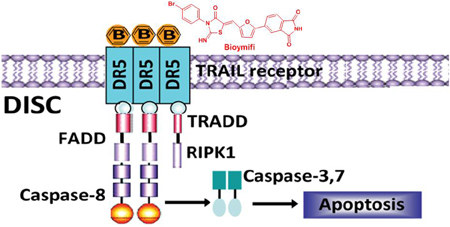Small Molecule Activation of the TRAIL Receptor DR5 in Human Cancer Cells
Wang, G.; Wang, X.; Yu, H.; Wei, S.; Williams, N.; Holmes, D. L.; Halfmann, R.; Naidoo, J.; Wang, L.; Li, L.; Chen, S.; Harran, P.; Lei, X.* ; Wang, X. *
Nat. Chem. Biol. 2013, 9, 84-89. ( News stories describing this work were highlighted in Chem. & Eng. News 2013 , 2 , 37 ; Nature Asia 2012 , December 24)
Tumor necrosis factor (TNF)-related apoptosis-inducing ligand ( TRAIL ) activates apoptosis through the death receptors DR4 and DR5 . Because of its superior safety profile and high tumor specificity compared to other TNF family members, recombinant soluble TRAIL and agonistic antibodies against its receptors are actively being developed for clinical cancer therapy. Here, we describe […]
Tumor necrosis factor (TNF)-related apoptosis-inducing ligand ( TRAIL ) activates apoptosis through the death receptors DR4 and DR5 . Because of its superior safety profile and high tumor specificity compared to other TNF family members, recombinant soluble TRAIL and agonistic antibodies against its receptors are actively being developed for clinical cancer therapy. Here, we describe the identification and characterization of the small molecules that directly target DR5 to initiate apoptosis in human cancer cells. The activity was initially discovered through a high-throughput chemical screen for compounds that promote cell death in synergy with a small-molecule mimetic of Smac , the antagonist for inhibitor of apoptosis protein. Structure-activity relationship studies yielded a more potent analog called bioymifi, which can act as a single agent to induce DR5 clustering and aggregation, leading to apoptosis. Thus, this study identified potential lead compounds for the development of small-molecule TRAIL mimics targeting DR5 for cancer therapy.
